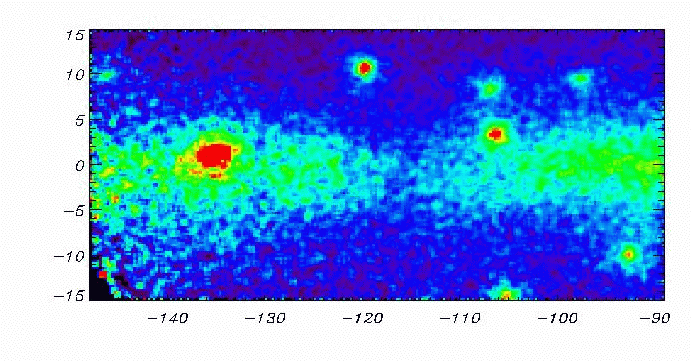



Next: AGILE performances optimization
Up: Observing the Diffuse Emission
Previous: AGILE and the Diffuse
Contents
A good knowledge of the diffuse emission model is important also for sources analysis.
In order to test the performances of our model from this point of view,
we have simulated a set of ten AGILE observations with photons energy above 100 MeV of the second quadrant sky region for a total observing time of about 5 months.
In these simulations we have included the diffuse emission model, the point sources from third EGRET catalog and a component of noise due to residual particle background.
We have chosen 2GC 135+1 as test source for our analysis.
The assumed flux is  photons per
photons per  per second above 100 MeV.
per second above 100 MeV.
We performed two maximum likelihood analysis [Chen et al., 2004] on the test source using the AGILE and the EGRET models.
Table 3.1:
Results of ALIKE analysis for the two models
| Parameter (unit) |
Value |
|
|
| 2GC 135+01 |
Flux (
 ) ) |
G mult |
G bias |
| EGRET model |
179 5 5 |
0.271 |
11.1 |
| AGILE model |
149 5 5 |
0.789 |
7.85 |
Table 3.6 summarizes the results of the analysis.
Second column represents the estimated flux of the test source.
We found a better agreement with the simulated value using the AGILE model.
Two more parameters are provided by the maximum likelihood method,
the multiplicative (G-mult) and additive (G-bias) terms which allow the diffuse emission model used to better fit to the simulation.
Also in this case we can notice that a smaller correction is needed for the AGILE model.
Figure 3.22:
The AGILE (simulated) observations of the Galactic plane near 2CG 135+01, for energy  100 MeV, composed of ten AGILE pointing
of the second quadrant sky region for a total observing time of about 5 months. with photons energy above 100 MeV.
A component of noise due to residual particle background is also present in the simulation.
100 MeV, composed of ten AGILE pointing
of the second quadrant sky region for a total observing time of about 5 months. with photons energy above 100 MeV.
A component of noise due to residual particle background is also present in the simulation.
 |




Next: AGILE performances optimization
Up: Observing the Diffuse Emission
Previous: AGILE and the Diffuse
Contents
Andrea Giuliani
2005-01-21
